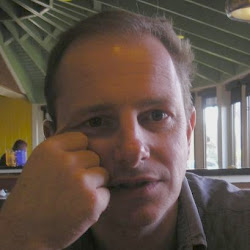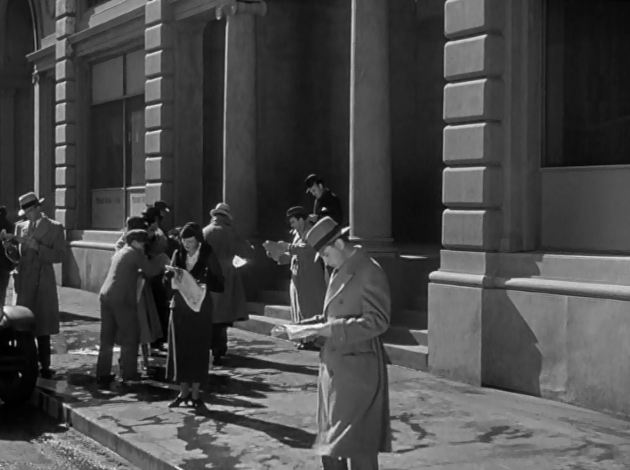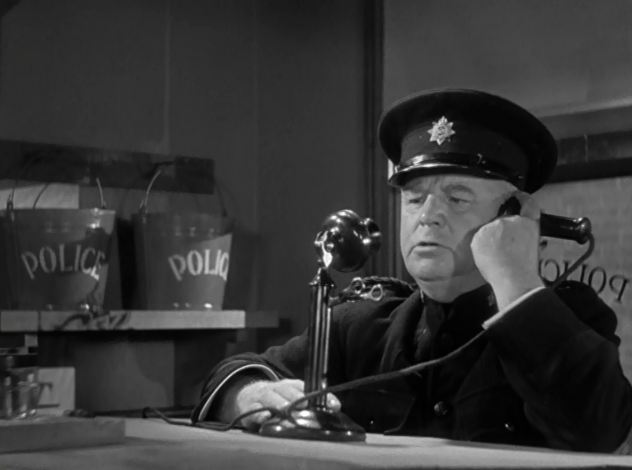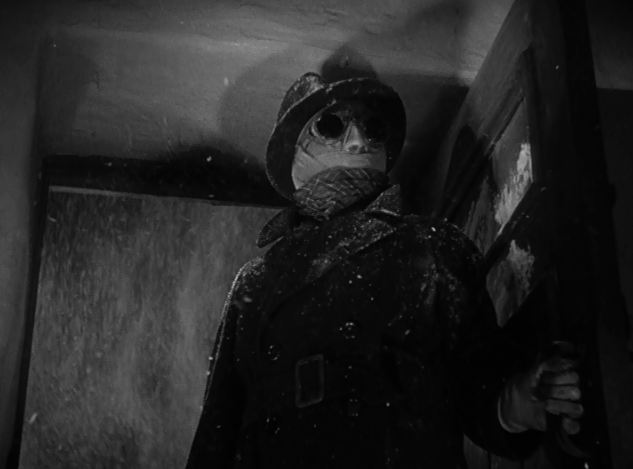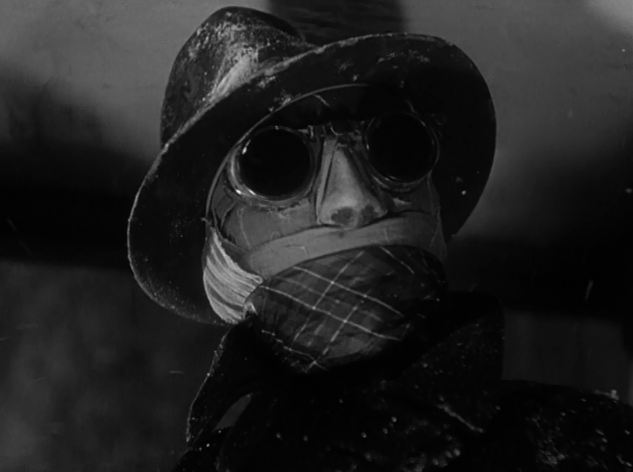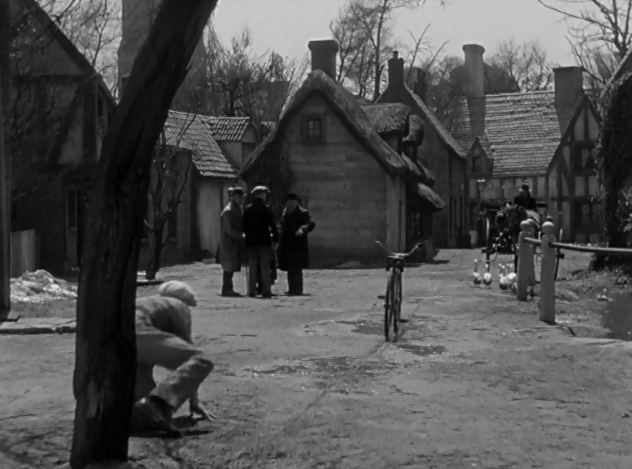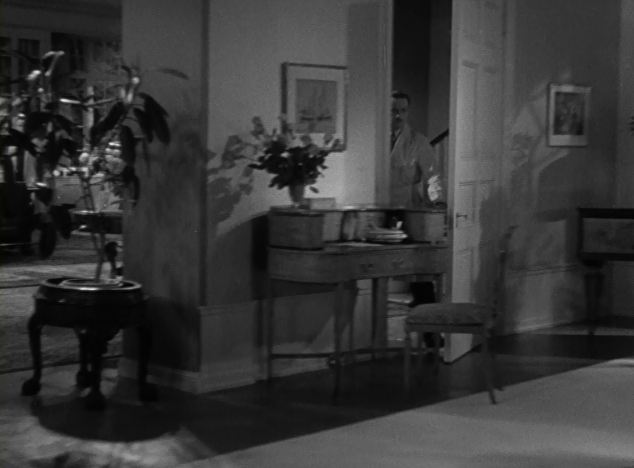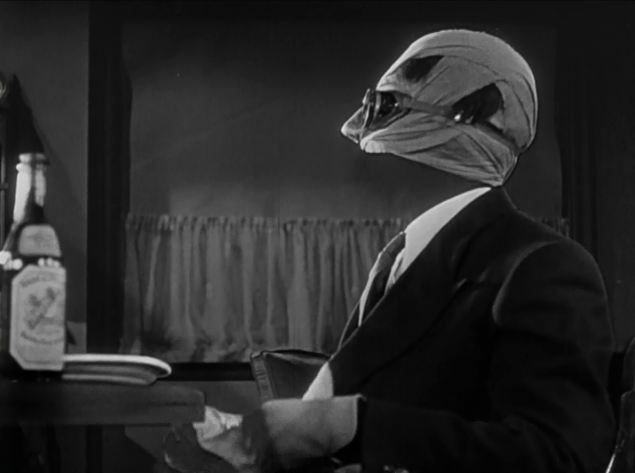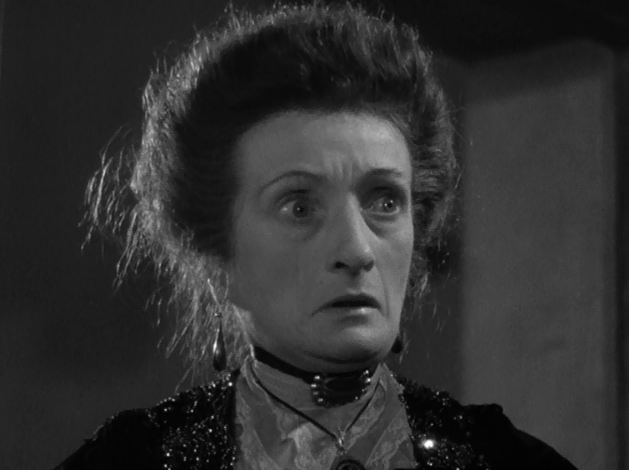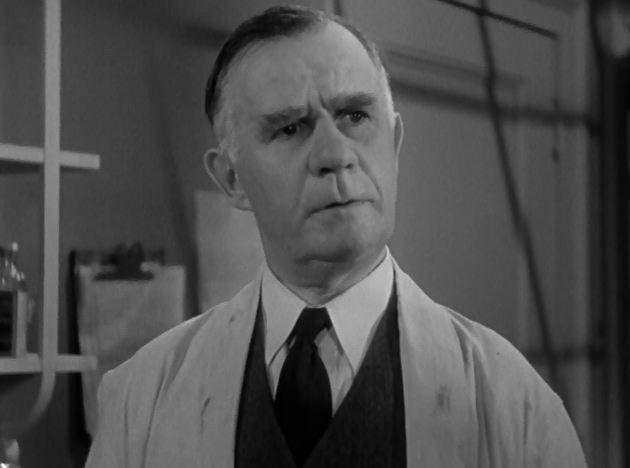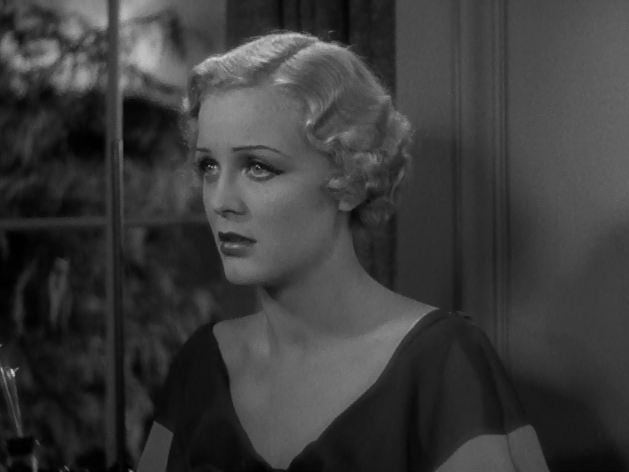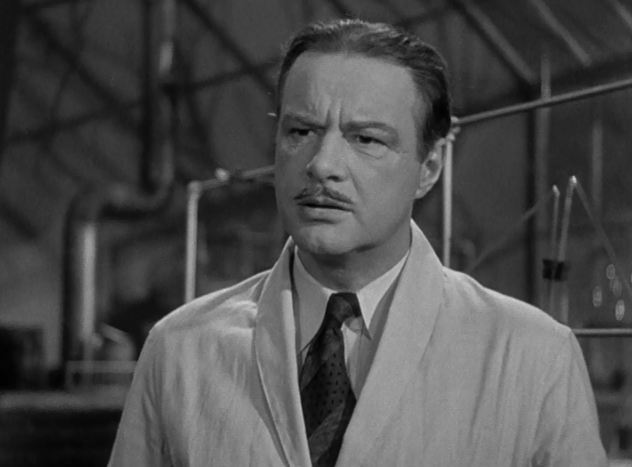One of the successes of the 1933 The Invisible Man is the crumminess that is brought to the rural English setting. The village and its folk, the walls, floors, doors and backgrounds contain a real sheen of indigence and a low quality look.
It's something you see in other films od the time, like Frankenstein and it's a feel that was carried forward into other interpretations of Europe made by Hollywood.
There is one strange exception to this, which is a brief cut into a busy American street scene. You can tell it’s North America because of the sharp guys in suits and the pillars which front the municipal building we see.
Downtown America becomes Crummy Little England
"Hey! What's the big idea?!"
James Whale’s style is well exemplified by this cut. What he does very well is use short scenes of only a matter of seconds, one built on top of another with as many as ten in a row, to tell a lot of story and to show a lot of different reactions.
This split second setup, which follows the discovery of the invisible man in Iping, shows a contemporary American downtown, with its faux portico and columns, and is as unrealistic to England as the chief policemen’s hats.
In 1933 however the story tripped out faster than it had ever done, rendering The Invisible Man, with its great special effects, one of the cultural marvels of the moment.
When The Invisible Man was made in 1933, it wasn’t the best time to be dreaming monsters. By the time Universal came to make what it planned to call The Return of Frankenstein, censor interference was reaching new heights.
Now there were church-based groups involved too, such as the ferocious Catholic Legion of Decency, and there was a new body called the Motion Picture Production Code Administration (read more on the Hays Office, or the Production Code here) which had enough power to pull the plug on nearly anything, and even deny cinematic exhibition.
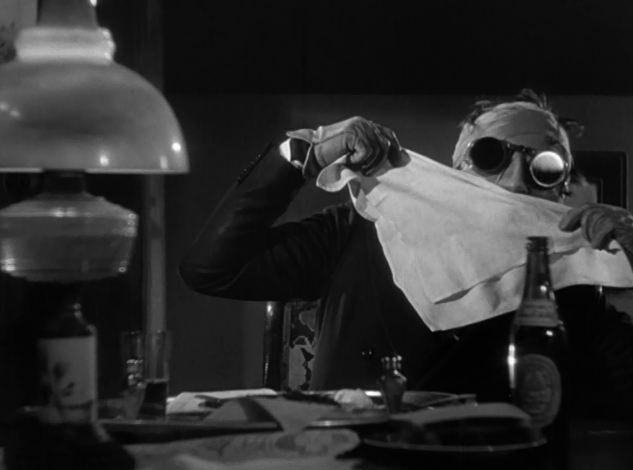
Given that it was Frankenstein that had prompted these angry villagers to rise, James Whale was one for whom production became trickier. Diplomacy and logistic expedience were required. If The Invisible Man was going to be a hit, it would have to make its way through a veritable minefield of moral and puritanical assault, and there could be no room for error, or suggestion of corruption within its confines.
The Return of Frankenstein became Bride of Frankenstein (1935), which was a step back in one sense but ultimately turned out to be Whale’s undisputed masterpiece.
In the interim, James Whale became more confident and colourful a director. Films like The Old Dark House and The Invisible Man are for Whale, black comedies, and the Frankenstein sequel was conceived of as a black comedy right from the start.
The Invisible Man then finds istelf embroiled in manners and mystry, special effects and farce, and isn't pitched as a tale of evil, although it roughly skirts alongside much of the narrative of the original novel.
"That boicycle be roiding by itself!"
The Invisible Man is a great place to study movie conventions, and how they arose. You wouldn’t know it today but the basic structures, roles and formats of your average cinematic entertainment, draw their roots not from fiction and neither from the dramatic stage, but from vaudeville.
It shows in The Invisible Man. Despite the fact that James Whale was clearly ahead of the pack, the actors in The Invisible Man still look like they are still unsure as to how to be on screen. To this end they act for the stage, shouting at one another with wide faces which ignore the nuances possible in the close up.
The same applies to some of the set dressing, the most noticeable of which are the huge amounts of flowers that adorn the foreground when Gloria Stuart playing Flora Cranley is wringing her hands worrying about Griffin.
There is also a theatrical style set-split that is very efefctive but then went out of fashion until much more recently. You can see that in the still above, in which the camera bypasses the cut by travelling over the theatrical barirer between rooms. The actor is using the door, but the camera slides from room to room, with the partition artfully masked by a pot plant on an occasional table.
Although special effects were put into play the very first day that cinema began, they reached a certain point of sophistication and even satisfaction in The Invisible Man. Music Hall rears its crazy head at one point, when the invisible man chases some yokels round his table, but on the whole, the effects are good and creepy.
The effects (by John P. Fulton, John J. Mescall and Frank D. Williams) were slick variations on techniques that had been tried before. Claude Rains was shot in a completely black velvet suit against a black velvet background and this film was combined with another shot of the location the scene, using a matte process.
Claude Rains felt claustrophobic and it was hard to breathe through the suit, apparently. Consequently, the work was difficult for him, and a double who was somewhat shorter than Rains was sometimes used.
The final effect however was stunning. Rains was seen to disappear by using a head and body cast from which a mask was made. The mask was then photographed against a specially prepared background, and the film was treated in the laboratory to complete the effect.
H.G. Wells said that he liked the picture, and he would have been bound to. He did however find one fault with it which was that it had taken his brilliant scientist and changed him into a lunatic, a liberty he could not condone. I guess he’d still find that the case today. Even if films do show scientists as brilliant, they still turn out to be lunatics. It’s one way in which we rationalise the homicidal tendencies we attribute to them. As it happens, the character in HG Wells’ novel is in his own way thoroughly immoral, and a thief who appears to cause his own father’s suicide, so Griffin is never far from madness.
As for the adaptation, there is a very good reason why Hollywood appeared to throw out the original text when it worked on this, and that was because it never had one to begin with.
When screenwriter R.C. Sherriff came to write The Invisible Man, he asked the staff at Universal for a copy of the novel, but they didn’t have one. All they had were 14 treatments done by other writers, including one set in Czarist Russia and one set on Mars. Many of these treatments were based on Philip Wylie's The Murderer Invisible, another Universal property.
Sherriff did read the book however, and the script iscloser to the book than the Universal versions of Dracula and Frankenstein. The film of course maintains a few of the names of the characters in the book and it tries here and there to capture the small town madness of the novel, but in brief the story that HG Wells tells achieves its power from its parochial setting, which makes it all the more real.
Mention must be made of James Whale's pre-eminent screamer, Una O'Connor, who would later turn up in The Bride of Frankenstein.
Then there is Gloria Stuart, who sixty five years after this film was made received an Oscar nomination for supporting actress for Titanic. The acting of the invisible man himself is worthy of note — especially since he is not there. It could even be suggested that this absence is made up for with an intense characterisation using Claude Rains’ very clear voice — dubbed post-production for further clarity — and a baroque playfulness that elicits a hint of sympathy, given that facial context is absent.
The inclusion of Dr. Cranley (played by Henry Travers, whom you’ll know as Clarence in It's a Wonderful Life) and his daughter Flora (Gloria Stuart, seen in The Old Dark House) are both formula film fodder, it’s fair to say, and bolster to something that was developing in cinema at the time, a basic blueprint that would still work today if people still made 70 minute feature films.
Neither of these are character is in H. G. Wells' novel, and they don't feel like a part of the story, often adding tiresome info-dump style speeches to break up the madcap fun and creeps.
"I'm so worried about you, Griffin!"
"Dashed peculiar business this of yours, Griffin!"
In terms of structure, it’s clear that Griffin would benefit from a kindly scientific opposition, such as Utterson is to Dr Jekyll in The Strange Case of Dr Jekyll and Mr Hyde. The downside is that Henry Travers and Gloria Stuart oblige the film to present an extraneous romance that goes nowhere.
Dash it all, there is no romance in the novel, but Wells could never have predicted cinema’s craven desire for snogging and female leads, way back in 1890 when he hit upon the idea.
As was going to happen forever more, popular novels were going to be squeezed into linear form (there is a good amont of backtracking from backstory in the novel The Invisible Man), given vaudeville heroines and villains, and reconceived with as many other conceits as were thought necessary to pack the enjoyment of their most basic features into a ninety minute audio-visual spectacle.
